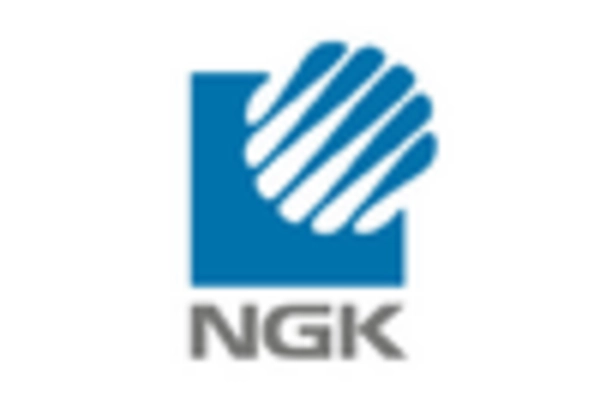Sustainability Initiatives
Sustainability initiatives are becoming increasingly pivotal within the Electronic and Electrical Ceramic Market. As environmental concerns gain prominence, manufacturers are focusing on developing eco-friendly ceramic materials that minimize environmental impact. This shift is evident in the adoption of sustainable production processes and the use of recycled materials in ceramic manufacturing. The market is responding to regulatory pressures and consumer preferences for greener products, which is expected to drive growth. In fact, the market for sustainable ceramics is anticipated to expand significantly, with projections indicating a potential increase of 8% in market share over the next decade. This trend not only aligns with The Electronic and Electrical Ceramic Industry.
Rising Demand in Emerging Markets
The Electronic and Electrical Ceramic Market is witnessing a notable increase in demand from emerging markets. Countries in Asia-Pacific and Latin America are experiencing rapid industrialization and urbanization, leading to heightened consumption of electronic devices. This trend is particularly evident in sectors such as telecommunications, automotive, and consumer electronics, where ceramics play a crucial role in enhancing product performance. The market in these regions is projected to grow at a rate of 7% annually, driven by the increasing adoption of advanced technologies and the expansion of manufacturing capabilities. As these markets continue to evolve, the Electronic and Electrical Ceramic Market is likely to benefit from the growing need for high-quality ceramic components that meet the demands of modern applications.
Growing Applications in Renewable Energy
The Electronic and Electrical Ceramic Market is increasingly influenced by the growing applications in renewable energy technologies. As the world shifts towards sustainable energy solutions, ceramics are finding new roles in solar panels, wind turbines, and energy storage systems. Their unique properties, such as high dielectric strength and thermal stability, make them ideal for use in these applications. The market for ceramics in renewable energy is projected to grow at a rate of 9% over the next five years, driven by the global push for cleaner energy sources. This trend not only enhances the relevance of the Electronic and Electrical Ceramic Market but also positions it as a key player in the transition towards a more sustainable energy landscape.
Technological Advancements in Electronics
The Electronic and Electrical Ceramic Market is experiencing a surge in demand due to rapid technological advancements. Innovations in materials science have led to the development of high-performance ceramics that exhibit superior electrical insulation and thermal stability. These advancements are particularly relevant in the production of capacitors, insulators, and piezoelectric devices, which are essential components in modern electronic applications. The market is projected to grow at a compound annual growth rate of approximately 6.5% over the next five years, driven by the increasing integration of ceramics in consumer electronics and automotive sectors. As manufacturers continue to invest in research and development, the Electronic and Electrical Ceramic Market is likely to witness enhanced product offerings that cater to the evolving needs of various industries.
Increased Investment in Research and Development
Investment in research and development is a critical driver for the Electronic and Electrical Ceramic Market. Companies are allocating substantial resources to innovate and improve ceramic materials, focusing on enhancing their electrical properties and thermal resistance. This emphasis on R&D is essential for developing next-generation ceramics that can withstand the demands of high-performance applications. The market is expected to see a rise in collaborations between academic institutions and industry players, fostering innovation and accelerating product development. As a result, the Electronic and Electrical Ceramic Market is likely to experience a wave of new products that cater to the evolving needs of various sectors, potentially increasing market competitiveness and expanding application areas.

















Leave a Comment